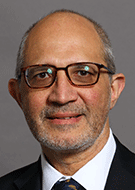Point-of-Care Ultrasound: Advancing Patient Care at the Bedside
Growing numbers of non-radiologists are using bedside ultrasound to diagnose and monitor patients’ conditions


An increasing number of physicians are using point-of-care ultrasound (POCUS) during office visits, in the in-patient setting and in the ED. The result? Improved patient care, as long as the physicians receive proper training, according to Paul S. Sidhu, MD, professor of imaging sciences at King’s College Hospital in London.
“The increase in POCUS use is driven by the availability of machines that are vastly superior to those seen only 10 years ago,” Dr. Sidhu said, noting that there have been major advancements in sophistication and portability.
“An ultrasound probe can now be used with a mobile phone or tablet,” Dr. Sidhu continued. “The cost is also lower than it was previously. With many medical students now being taught to use ultrasound, it is really an important extension of the clinical examination.”
POCUS in the ED
Physicians in the emergency department (ED) have been using POCUS for more than a decade at the Children’s Hospital of Philadelphia (CHOP), according to Kassa Darge, MD, PhD. Dr. Darge is radiologist-in-chief and chair in the Department of Radiology at CHOP and professor of radiology and surgery at the Perelman School of Medicine at the University of Pennsylvania.
“The organization of POCUS at CHOP is somewhat unique,” he said. “POCUS is highly supported by the Department of Radiology. Together with the institution, we established the position of CHOP director for POCUS, which is filled by a pediatric radiologist, Summer Kaplan, MD.”
The CHOP director for POCUS organizes and streamlines POCUS-related activities across all subspecialties at the institution, Dr. Darge explained. With support from a radiology manager, the director for POCUS reviews and approves all the credentialing applications, coordinates quality improvement monthly sessions, ensures POCUS images are archived in the radiology PACS and oversees the purchase of US scanners for POCUS.
“There is a strong working relationship between the different POCUS teams and radiology,” he said. “The ED POCUS team is the longest running and most advanced one with its own ED POCUS fellowship, which is also supported by the Department of Radiology.”
“Quick-Look” Ultrasound During the Pandemic and Beyond
According to Dr. Sidhu, COVID-19 created a greater awareness of POCUS, given that lung ultrasound gives physicians a great deal of information without needing to move patients to a static CT scanner.
“During the pandemic, the ubiquity of using a bedside tool was obvious to all for safety and accuracy,” he said. “The literature illustrated the importance of ultrasound as a tool for many instances of patient management. By bringing the imaging tool to the patient, it likely saved the hard-pressed clinical teams so much time.”
POCUS was also particularly helpful at his institution during the height of the pandemic, commented Dr. Darge. “We had POCUS before COVID-19, but during the pandemic it became clear how useful it is, as the frontline clinicians could take care of some imaging and intervention needs, reducing the need for additional personnel,” he said.
“As a radiologist skilled in ultrasound, helping others to learn the technique is paramount. Time-starved radiologists can use their time more efficiently by performing more sophisticated scans, leaving the scans that need to be performed immediately to the people who are face-to-face with the patient.”
—PAUL S. SIDHU, MD
Some have predicted that POCUS may replace the stethoscope as the standard triage tool. In Dr. Sidhu’s view, POCUS likely has already done this.
“POCUS may not replace it fully, but certainly it has reduced the need for a stethoscope in many situations—for example, in cardiac auscultation,” Dr. Sidhu said. “This is not a bad development, as better accuracy is clearly of benefit. I am sure we were saying the same thing about the stethoscope replacing clinical examination all those years ago.”
Radiology does not have exclusive rights to ultrasound, he added. “It is used by many different practitioners,” Dr. Sidhu said. “As a radiologist skilled in ultrasound, helping others to learn the technique is paramount. Time-starved radiologists can use their time more efficiently by performing more sophisticated scans, leaving the scans that need to be performed immediately to the people who are face-to-face with the patient.”
Use of POCUS by non-radiologists should not worry radiologists, he added. “There should be no concern over this, so long as the person who is performing the ultrasound examination is trained and competent, and restricts their practice to their area of expertise,” Dr. Sidhu said. POCUS, he notes, is point-of-care investigation to solve an immediate issue, while US practiced in radiology departments uses a more holistic diagnostic technique.
“It is incumbent upon the radiologist to be up to date with all new innovations in ultrasound and apply this to clinical practice,” Dr. Sidhu said. “This holistic approach has a very important role in the overall imaging of a patient and is best performed by the radiologist in conjunction with overall care. This will not change.”
Dr. Darge agreed.
“POCUS is widespread and here to stay,” he said. “With the scanners becoming smaller, POCUS is becoming easier to carry out, but it needs appropriate training. It is easier to limit the indications and train non-radiologists to use it for a specific application.”
“We certainly should not see it as a threat,” Dr. Darge added, “but as an opportunity for multidisciplinary collaboration.”
For More Information
Access the RSNA Online Learning Center for available content on ultrasound.
Read previous RSNA News stories on ultrasound: